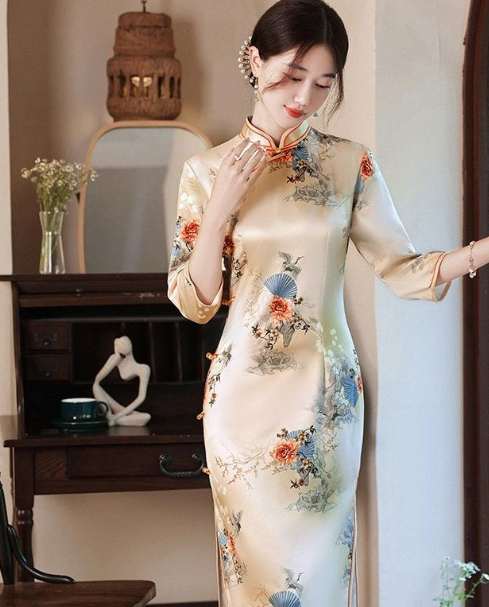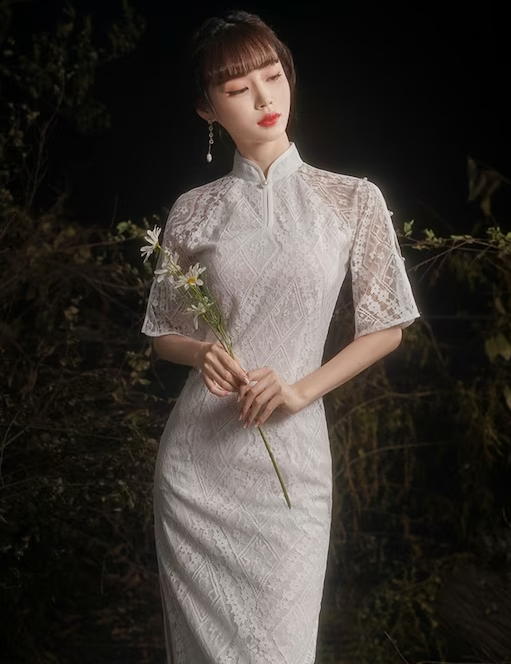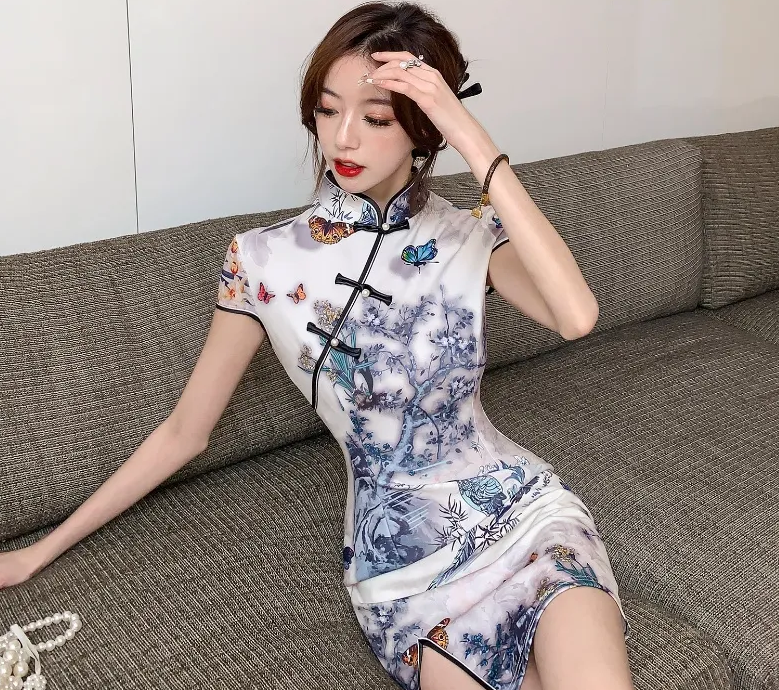The qipao features a high collar, side slits, and is often made of silk with intricate designs.
Design and Aesthetics
Qipao, also known as the Cheongsam, is an epitome of Chinese fashion that seamlessly melds tradition with elegance. Through time, its design has evolved, but the core aesthetics that define it remain unchanged. Here’s a dive into the significant design elements that make the Qipao stand out.

Classic Silhouette and Fit
The Qipao boasts a figure-hugging silhouette that accentuates the curves of the wearer, without being overly revealing. Traditionally tailored to the individual, it offers a perfect fit that speaks volumes of its bespoke nature. It often comes in a length that either reaches the ankle or just above the knee. The slits on either side, not only allow ease of movement but also add a touch of sensuality to the attire. While modern versions might offer variations in the fit and length, the essence of the classic silhouette remains intact.
Read more about the history of Qipao on Wikipedia
Signature High Collar
One of the most distinguishing features of the Qipao is its high mandarin collar. Standing tall around the neck, it offers an air of regality and sophistication to the dress. Originally, the collar was designed not just for aesthetics but also to protect the neck from cold winds during chilly weather. Today, it stands as a testament to the timeless nature of Qipao’s design.
Decorative Buttons and Pankous
Pankous, often referred to as the Chinese “frog” buttons, are knotted cloth buttons that serve as functional and decorative elements on the Qipao. These intricate buttons can be found running diagonally across the right side of the dress, starting from the collar and often going down to the armpit. The craftsmanship behind creating these buttons is intensive, often taking a tailor many hours to perfect. The design and placement of these pankous have evolved over time, with modern Qipaos featuring a variety of innovative patterns and designs.
Discover the art of Pankou making on Wikipedia
The elements mentioned above are just a few of the many intricate details that make up the Qipao. With its rich history and timeless elegance, the Qipao remains an enduring symbol of Chinese culture and fashion.
Materials and Fabrics
The allure of the Qipao not only lies in its design but also in the materials and fabrics used. Through history, the choice of materials has played a pivotal role in showcasing both the elegance and the cultural importance of this attire. Let’s delve into the fabrics that have given life to the Qipao.
Traditional Silk and Satin
Silk, revered for its luxurious sheen and unmatched softness, has been the material of choice for the Qipao for centuries. Originating from the ancient silk-producing regions of China, this material embodies the rich heritage and sophistication of Chinese culture. Silk Qipaos often come with a higher price tag due to the quality of the fabric and the intricate process of silk harvesting.
Satin, another popular choice, offers a glossy finish that perfectly complements the figure-hugging silhouette of the Qipao. While slightly less expensive than silk, satin Qipaos are equally sought after for formal occasions, given their radiant shine and smooth texture.
Explore the history of silk on Wikipedia
Modern Variations and Blends
As fashion evolved, so did the materials used for Qipao. Modern variations include fabrics like cotton, polyester, and even velvet. These materials, while deviating from tradition, offer durability, ease of care, and affordability. A polyester Qipao, for instance, is often more cost-effective, with prices ranging from $50 to $200, depending on the craftsmanship and design intricacies.
Blended fabrics, which mix traditional and modern materials, have also gained popularity. A common blend is silk-cotton, which offers the luxury of silk while ensuring more breathability and comfort, especially in warmer climates.
Discover modern fabric blends on Wikipedia
Embroidery and Beading Details
A distinguishing feature of high-end Qipaos is the intricate embroidery and beading that adorns them. From delicate floral patterns to mythical dragons and phoenixes, the designs showcase the craftsmanship and artistry of the tailors. These details, often done by hand, can significantly increase the value of a Qipao, with some hand-embroidered pieces fetching prices upwards of $1,000.
Beads, often made of pearls or semi-precious stones, add an additional layer of opulence to the dress. The time and effort to meticulously place each bead can add hours to the tailoring process, making these Qipaos treasured pieces for special occasions.
Cultural Significance
The Qipao, more than just a piece of clothing, is an emblem of Chinese culture and heritage. It has weathered the test of time, evolving with societal changes while retaining its intrinsic cultural identity. The significance of the Qipao extends far beyond fashion; it tells a story of China’s history, its women, and the continuous dialogue between tradition and modernity.
Representation in Film and Media
The Qipao has had a notable presence in film and media, both within China and internationally. Classic films like “In the Mood for Love” by Wong Kar-wai showcased the Qipao as an essential part of the narrative, highlighting its elegance and allure. The dress has also made appearances in Hollywood productions, where it often symbolizes the mystique and beauty of the East.
Furthermore, the Qipao has been featured in numerous TV shows, commercials, and print media, cementing its status as an iconic piece of Chinese culture. The global media exposure has further popularized the Qipao and broadened its appeal to international audiences.
Explore the influence of Qipao in films on Wikipedia
Qipao as Symbol of Femininity and Elegance
Historically, the Qipao was worn by women of all ages and social statuses. Its figure-hugging silhouette, combined with the high collar and side slits, showcased a woman’s grace while maintaining an air of modesty. Over the decades, the Qipao has come to symbolize femininity, empowerment, and elegance in Chinese culture. It’s not just a dress; it’s an embodiment of a woman’s dignity, strength, and beauty.
Learn about the cultural evolution of Qipao on Wikipedia

Modern Interpretations and Controversies
With the global spread and adaptation of the Qipao, there have been multiple modern interpretations that deviate from its traditional design. Some of these adaptations incorporate elements of Western fashion, such as shorter hemlines or different fabrics. While many appreciate these innovations, purists argue that they detract from the Qipao’s cultural essence.
Moreover, controversies have arisen when the Qipao is worn without understanding or respecting its cultural significance, leading to accusations of cultural appropriation. It’s essential for wearers, especially those from outside the culture, to approach the Qipao with respect and a genuine desire to appreciate its historical and cultural context.
Wearing and Customization
The Qipao is not just a dress but an experience. It provides a unique blend of tradition and personal style. Wearing a Qipao is not just about donning a piece of clothing; it’s about embracing an entire culture. Moreover, as with any timeless piece of fashion, the Qipao offers ample opportunities for customization and adaptation to suit individual preferences and modern lifestyles.
Suitable Occasions for Wearing Qipao
While historically the Qipao was an everyday attire for many Chinese women, its use in modern times has become more selective. Today, it’s a popular choice for special occasions like weddings, where brides often wear a red Qipao as a symbol of luck and prosperity. Other events include Chinese New Year celebrations, birthdays, and formal gatherings. Additionally, in some business settings, especially during events that celebrate Chinese partnerships or heritage, the Qipao can be a graceful way to represent one’s cultural roots.
Discover more about Chinese weddings on Wikipedia
Personalized Patterns and Designs
Customization has always been at the heart of the Qipao experience. Buyers can choose from a range of fabrics, from traditional silk to modern blends. Personalized patterns, often reflecting nature motifs like flowers, birds, or landscapes, can be embroidered onto the dress. These patterns can be tailored to tell a story or represent personal symbols of luck, love, or prosperity. This level of customization, especially for hand-embroidered designs, can increase the price, with custom Qipaos often ranging from $300 to well over $1,500 based on the intricacy and craftsmanship involved.
Read about traditional Chinese motifs on Wikipedia
Modern Adaptations for Comfort and Flexibility
Modern lifestyles demand flexibility and comfort, and the Qipao has adapted accordingly. Contemporary Qipaos often incorporate stretchable fabrics, side pockets, and zippers for added convenience. While the traditional high collar remains popular, some modern designs offer variations like V-necks or lowered collars, especially for those seeking a blend of traditional and contemporary style.
Another adaptation is the hemline. While the classic Qipao often reaches the ankles, modern variations might be knee-length or even shorter, offering a more casual and versatile look. These adaptations make the Qipao suitable for various occasions, from formal events to casual outings.

Craftsmanship and Production
The Qipao, an emblematic representation of Chinese culture, is a testament to the country’s rich legacy of craftsmanship and artisanship. Behind every stitch and fold is a story of dedication, precision, and an unyielding commitment to excellence. As the world has modernized, so too has the process of Qipao production. Yet, the essence of traditional craftsmanship remains undiluted, serving as a bridge between the past and the present.
Traditional Hand Sewing Techniques
Before the age of machines and mass production, the Qipao was hand-sewn by skilled artisans. Using techniques passed down through generations, these craftsmen employed specialized stitches to ensure the dress’s durability and elegance. One of the most intricate aspects of this process is the embroidery. Employing silk threads on silk fabric, artisans would meticulously craft motifs, often taking weeks to complete a single piece.
The sewing technique also ensured that the Qipao fit the wearer’s body perfectly. Given that every individual’s body is unique, this custom-fit was essential to achieve the Qipao’s characteristic elegant silhouette. The process, due to its intensive labor and time requirements, meant that traditionally crafted Qipaos could be quite expensive, with prices ranging anywhere between $500 to over $2,000, depending on the intricacy.
Learn more about traditional Chinese embroidery on Wikipedia
Role of Master Tailors
Master tailors are the guardians of the Qipao’s legacy. With years, often decades, of experience under their belts, these masters possess an unrivaled knowledge of the craft. A master tailor doesn’t just see a piece of fabric; they envision the finished Qipao, understanding how every fold, stitch, and pattern comes together.
Their role extends beyond just production. They serve as mentors, passing on their knowledge to apprentices, ensuring that the traditions and techniques of Qipao-making survive the test of time. The expertise of a master tailor adds a premium to the Qipao’s cost, but for many, the unparalleled fit and finish they offer are worth the investment.
Dive deeper into the world of tailoring on Wikipedia
Modern Manufacturing vs. Traditional Craftsmanship
The age of industrialization brought forth a new era for Qipao production. Modern manufacturing techniques, using automated machinery and standardized patterns, can produce Qipaos at a fraction of the time and cost, with prices for machine-made pieces starting as low as $50. This accessibility has made the Qipao available to a broader audience.
However, while modern manufacturing excels in speed and cost-efficiency, it often lacks the personalized touch and attention to detail that traditional craftsmanship offers. The debate between the two methods is akin to choosing between a print and an original painting. Both have their merits, with machine-made Qipaos being more accessible and traditionally crafted ones holding a higher value in terms of craftsmanship and cultural significance.
Global Influence and Popularity
The Qipao, while rooted deeply in Chinese heritage, has transcended its origins to capture the fascination of the global fashion scene. Its timeless elegance, combined with its rich history, has made it an influential icon, not just in Asia but across continents. The story of its global ascent is one of appreciation, adaptation, and celebration.

The Spread of Qipao in International Fashion
From the bustling streets of Shanghai in the 1920s, the Qipao began its journey to international fame. European and American travelers, enamored by its beauty, began introducing it to Western audiences. High-end fashion magazines, such as Vogue, soon featured the Qipao, highlighting its elegance and unique design. By the 1960s, Hollywood stars like Marilyn Monroe and Grace Kelly were spotted donning Qipaos, cementing its status as an international fashion symbol.
While initially recognized as an exotic piece from the East, over time, the Qipao gained respect for its craftsmanship and design. Top fashion houses in Paris and Milan began to incorporate Qipao-inspired elements into their collections, further amplifying its global appeal.
Explore the history of international fashion on Wikipedia
Adaptations in Western Fashion
The West didn’t just adopt the Qipao; it adapted and reinvented it. Western designers, while retaining the Qipao’s signature silhouette, began experimenting with fabrics, patterns, and lengths to cater to local tastes. This led to the emergence of Qipao-inspired dresses that were shorter, made of different materials, and suited to Western aesthetics.
Moreover, the Qipao’s iconic high collar and side slits found their way into various Western designs, from evening gowns to cocktail dresses. This blending of East and West led to the creation of fusion dresses that were celebrated both for their innovation and their homage to traditional Qipao craftsmanship.
Discover more about Western fashion adaptations on Wikipedia
Qipao-Inspired Events and Celebrations
The global love affair with the Qipao isn’t just limited to fashion. Over the years, various Qipao-themed events and celebrations have popped up around the world. From Qipao beauty pageants in Bangkok to Qipao flash mobs in New York’s Times Square, the dress has become a symbol of cultural exchange and unity.
One notable event is the annual “Qipao Day” held in various cities, where participants, regardless of their cultural background, don the dress and partake in parades and photoshoots. Such events not only celebrate the Qipao’s beauty but also promote cultural understanding and appreciation.